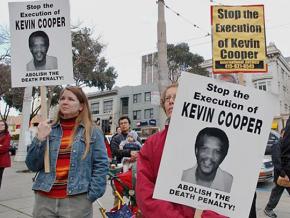Will Kevin Cooper finally get a fair hearing?
provides the backdrop to last month’s order for new DNA testing in the case of wrongfully convicted California death row prisoner Kevin Cooper.
ON DECEMBER 24, exiting California Gov. Jerry Brown ordered new DNA tests of physical evidence in the case of Kevin Cooper, whose high-profile conviction three decades ago in a quadruple murder has been consistently challenged by Cooper, his attorneys and anti-death penalty activists.
Brown called for “limited retesting of certain physical evidence in the case and appointing a retired judge as a special master to oversee this testing, its scope and protocols,” according to the order.
There were many serious problems in the police investigation and the subsequent prosecution of Cooper, including failing to pursue other possible suspects, and the foundation of racism upon which the case against Cooper was built. But the mishandling or destruction of evidence has been a single, unbroken thread across the more than three decades of this case.
Today, 33 years after the murder of Doug and Peggy Ryen, their daughter Jessica and houseguest Christopher Hughes, there remain large holes in the case against Kevin Cooper.

For one, law enforcement experts and others who have reviewed reports from the crime scene believe multiple attackers would have had to subdue all four victims. Additionally, blond hairs were found clutched in the hands of one victim, which couldn’t have come from Kevin, who is African American.
Several witnesses had seen three white men near the scene of the crime.
But there were other problems in the state’s case — including the fact that prosecutors originally claimed a shoe print at the scene could only have come from a tennis shoe worn by a prisoner. This supposedly implicated Kevin, who had escaped from a minimum-security prison two days before the murders.
Even as they made this claim, however, prosecutors knew that the shoes issued to prisoners were also widely available to the public.
KEVIN COOPER has consistently maintained his innocence and has never received a fair hearing of his claims. Commenting on post-conviction legal proceedings, five federal appellate judges wrote:
There is no way to say this politely. The district court failed to provide Cooper a fair hearing...The district court impeded and obstructed Cooper’s attorneys at every turn. [T]he court imposed unreasonable conditions...refused discovery that should have been available as a matter of course; limited testimony that should not have been limited; and found facts unreasonably, based on a truncated and distorted record.
Just weeks before leaving office, Brown has ordered limited testing as a result of public pressure.
That pressure is coming, in part, from the New York Times. On December 13, six former governors wrote an op-ed calling on Brown to follow in their footsteps and grant clemency to the more than 740 people on California’s death row, including Cooper.
New York Times columnist Nicholas Kristof also has written several high-profile articles supporting Kevin Cooper’s claims of innocence and highlighting the shoddy police and prosecution of the case.
The additional testing is welcomed by Kevin Cooper’s legal team and those who have been part of the decades-long effort to free Cooper. But it is also the case that Brown, a four-term governor and a Democrat, has taken the minimal action he could in response to this pressure.
Kevin’s execution has been scheduled multiple times. In 2004, he came within eight hours of being murdered by the state, only to have an appeals court step in at the last minute in the face of a tide of activism on his behalf, including protests across the state of California and the U.S.
“There can be a vigil for me after I am dead,” Kevin wrote in a widely distributed statement at the time, “but while I am alive, we must protest against my murder and this crime against humanity!”
This new ruling is another opportunity to raise our voices for an innocent man and take on the racism and inhumanity that is embedded in the death penalty.
Even as the testing proceeds, in the face of decades of naked evidence tampering, it will take a reignited movement of a new generation of activists to get justice for Kevin Cooper and see him walk out of San Quentin State Prison.
As Kevin himself explained in an article written for the New Abolitionist, the newsletter of the Campaign to End the Death Penalty, in 1999:
I am an activist and an abolitionist, and my work speaks to this. I know that the death penalty is not only about me, Kevin Cooper, but is much, much bigger. In my mind and through my eyes, this is about a system that has historically and systematically executed men, women and children who look just like me, whether from the standpoint of the color of their skin or from the standpoint of their class and background.
I am a part of the machine that we are building to put an end to this crime against humanity that this government uses. I am no more, and no less, than that.


